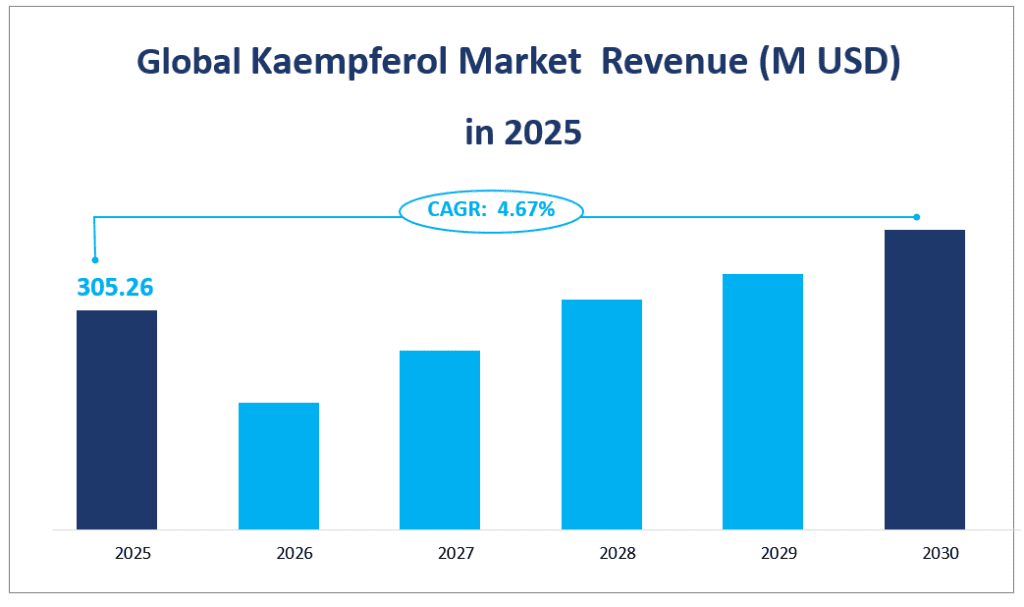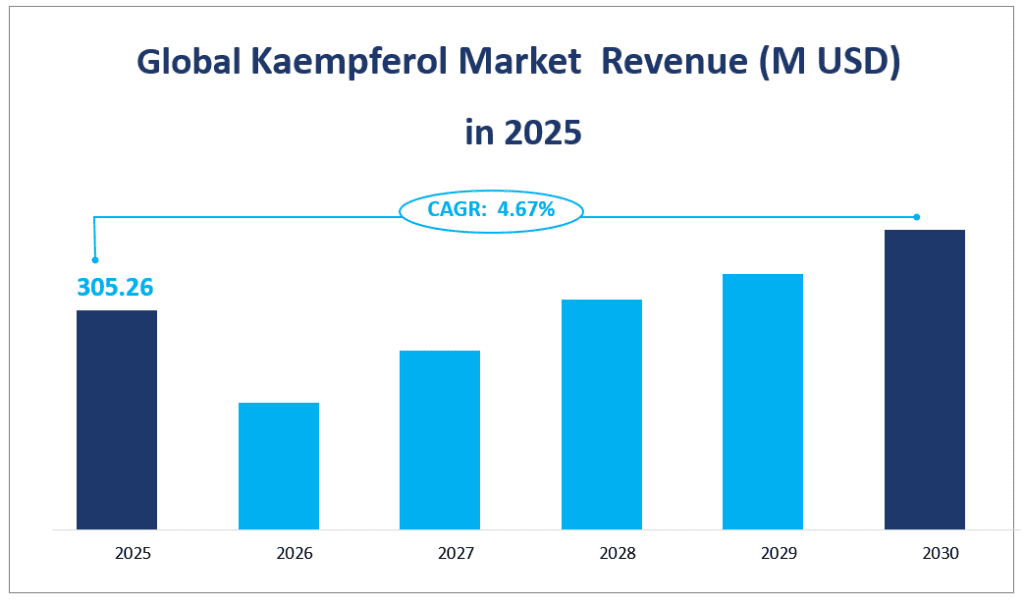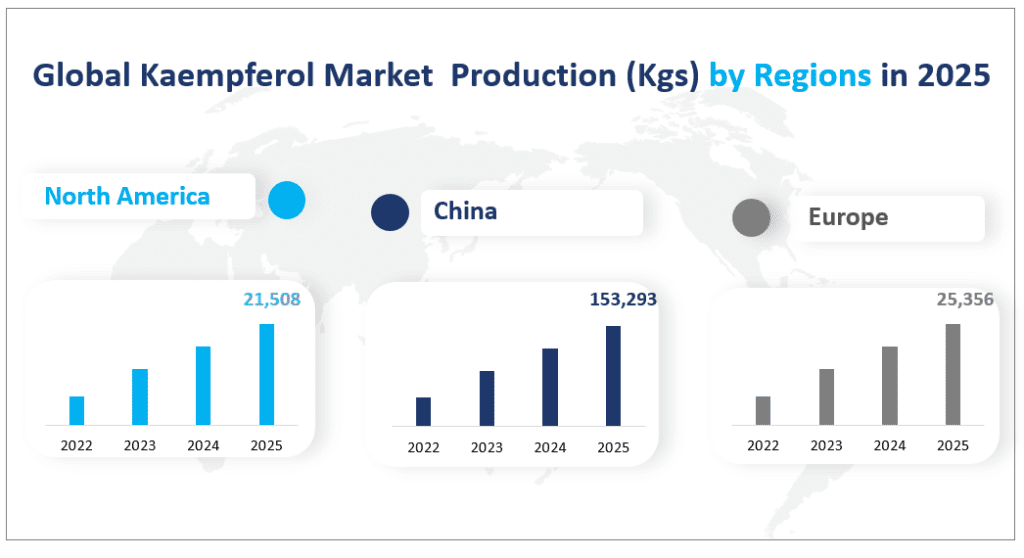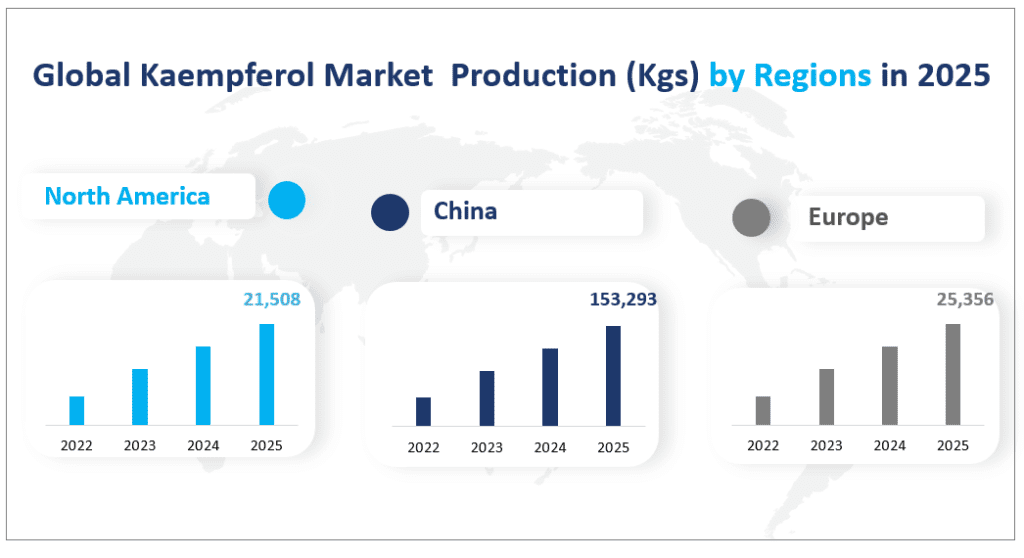1. Global Kaempferol Market Definition
The global Kaempferol market is projected to reach a revenue of $305.26 million with a CAGR of 4.67% from 2025 to 2030.
Kaempferol, a natural flavonoid compound, is extracted from various plants and plant-derived products. It is found in tea, broccoli, delphinium, witch hazel, grapefruit, Brussels sprouts, apples, and other plants. Known for its medical and nutritional benefits, Kaempferol is a yellow crystal with a melting point of 276-278°C, slightly soluble in water, and soluble in a hot mixture of ethanol and ether.
Kaempferol’s applications span across multiple industries, including pharmaceuticals, food and beverages, supplements, cosmetics, and animal nutrition. Its medicinal advantages include antioxidant, anti-inflammatory, and anticancer properties, making it a valuable component in various drug formulations. In the food industry, Kaempferol is used as a nutritional supplement due to its health benefits. Its presence in dietary supplements helps treat chronic diseases such as type 1 diabetes and chronic diarrhea.
Global Kaempferol Market Revenue (M USD) in 2025


2. Driving Factors of Kaempferol Market
Firstly, the increasing demand for natural and organic products has led to a surge in the use of Kaempferol in pharmaceuticals and dietary supplements. Consumers are increasingly aware of the health benefits associated with Kaempferol, such as its antioxidant and anti-inflammatory properties, which drive its adoption in various applications. The growing geriatric population also contributes to the market growth, as Kaempferol is used in products targeting old-age ailments like joint and bone diseases.
Another significant driver is the growing adoption of Kaempferol by the pharmaceutical industry. The compound’s ability to inhibit cancer cell growth and its potential in treating various chronic diseases make it a valuable ingredient in drug formulations. Additionally, the increasing prevalence of diseases such as cancer, diabetes, and obesity has led to higher demand for Kaempferol-based products. The focus on product innovation and the rising expenditure on research and development activities further bolster the market’s growth.
3. Limiting Factors of Kaempferol Market
However, the Kaempferol market also faces several limiting factors. One of the primary challenges is the presence of global brands that dominate the market. These brands often have a competitive advantage due to their established reputation and advanced technology. The food safety challenges associated with plant extracts, which are the primary source of Kaempferol, also pose a significant concern. The extraction process is energy-intensive and can be affected by climate and seasonal variations, leading to fluctuations in raw material prices.
In conclusion, while the global Kaempferol market is poised for significant growth due to its wide range of applications and health benefits, it must navigate several challenges to realize its full potential. Addressing these challenges through innovation, improved supply chain management, and increased consumer education will be crucial for the market’s sustained growth.
4. Analysis of Kaempferol Market Revenue by Product Type in 2025
98% Purity Kaempferol
Market Revenue in 2025: $286.83 million
The 98% purity Kaempferol, known for its high concentration and efficacy, dominates the market with a significant share. This type is highly sought after in pharmaceutical and dietary supplement industries due to its superior quality and effectiveness in treating various health conditions.
10% Purity Kaempferol
Market Revenue in 2025: $3.66 million
The 10% purity Kaempferol, while less concentrated, finds its niche in applications where lower purity levels are sufficient. This type is used in certain food and beverage products, contributing to the overall market revenue with a modest but steady growth rate.
50% Purity Kaempferol
Market Revenue in 2025: $9.89 million
The 50% purity Kaempferol serves as a middle ground between high and low purity types. It is utilized in a variety of applications, including cosmetics and some dietary supplements, where moderate purity is required. This type maintains a consistent market presence with a stable growth rate.
The 98% purity Kaempferol holds the largest market share, accounting for nearly 93.96% of the total revenue in 2025. This high-purity type is favored for its effectiveness in critical applications such as pharmaceuticals and high-end dietary supplements.
Kaempferol Market by Application
Pharmaceutical Application
Market Revenue in 2025: $244.20 million
The pharmaceutical sector is the primary driver of Kaempferol demand, utilizing its antioxidant and anti-inflammatory properties in various drug formulations. This application holds the largest market share, reflecting its critical role in treating chronic diseases and supporting overall health.
Food & Beverages Application
Market Revenue in 2025: $6.73 million
In the food and beverage industry, Kaempferol is used as a nutritional supplement, enhancing the health benefits of various products. While its market share is smaller compared to pharmaceuticals, it still contributes significantly to the overall market revenue with a steady growth rate.
Supplements Application
Market Revenue in 2025: $44.30 million
Dietary supplements are another significant application area for Kaempferol. These products leverage Kaempferol’s health benefits to support consumer wellness, contributing to a substantial portion of the market revenue with a consistent growth rate.
Cosmetics Application
Market Revenue in 2025: $1.89 million
The cosmetics industry utilizes Kaempferol for its antioxidant properties, enhancing product efficacy and consumer appeal. Although its market share is relatively small, it represents a niche area with growth potential.
Animal Nutrition Application
Market Revenue in 2025: $1.76 million
In animal nutrition, Kaempferol is used to support the health and well-being of livestock. This application contributes to the overall market revenue with a modest but steady growth rate.
The pharmaceutical application of Kaempferol holds the largest market share, accounting for nearly 68.66% of the total revenue in 2025. This sector’s dominant position is due to Kaempferol’s critical role in treating chronic diseases and supporting overall health. All applications exhibit a consistent growth rate of 3.91% CAGR from 2021 to 2027, indicating a stable market environment across different application areas.
Market Revenue by Segment
| Market Revenue (M USD) in 2025 | ||
| By Type | 98% Purity | 286.83 |
| 10% Purity | 3.66 | |
| 50% Purity | 9.89 | |
| By Application | Pharmaceutical | 244.20 |
| Food & Beverages | 6.73 | |
| Supplements | 44.30 | |
| Cosmetics | 1.89 | |
| Animal Nutrition | 1.76 |
5. Regional Kaempferol Market
North America maintains a notable presence in the Kaempferol market with a production of 21,508 kg in 2025, driven by its robust pharmaceutical and dietary supplement industries. The region’s high demand for high-purity Kaempferol in pharmaceutical applications and its strong consumer base for health and wellness products contribute to its significant production levels. The United States, in particular, is a major producer and consumer of Kaempferol-based products, supporting the region’s leading position.
Europe is a key player in the Kaempferol market with production of 25,356 kg in 2025, with substantial contributions from its pharmaceutical and cosmetics sectors. The region’s focus on natural and organic products aligns well with the growing demand for Kaempferol. Countries like Germany and the UK are significant producers and consumers, driving the overall market production and maintaining a steady growth rate.
China is emerging as a major production hub for Kaempferol with production of 153,293 kg in 2025, driven by rapid economic growth and increasing demand from the pharmaceutical and dietary supplement industries. China’s strong industrial base and focus on innovation have enabled it to become a leading producer of Kaempferol. The country’s expanding economy and growing consumer awareness of health benefits further support its dominant position in the market.
China is the largest production hub for Kaempfero. This region’s significant production share is driven by its strong industrial base, rapid economic growth, and increasing demand from various industries. All regions exhibit a consistent growth rate of 3.91% CAGR from 2021 to 2027, indicating a stable market environment across different geographical areas.
The Asia-Pacific region is expected to be the fastest-growing due to its rapid economic development and increasing demand from the pharmaceutical and dietary supplement industries. China, in particular, is a major driver of this growth, with its expanding economy and growing consumer awareness of health benefits. The region’s focus on innovation and sustainable sourcing further supports its growth trajectory.
Global Kaempferol Market Production (Kgs) by Regions in 2025


6. Analysis of Top 3 Companies in the Kaempferol Market
Company Introduction and Business Overview: Foodchem is a leading Chinese company specializing in the research, development, production, marketing, and distribution of innovative and standard food additives and ingredients. Established in 2006, Foodchem offers a wide range of products and services to over 5,000 customers in more than 120 countries.
Products Offered: Foodchem offers Kaempferol in various purity levels, including 98% purity, which is highly sought after in the pharmaceutical and dietary supplement industries. The company’s product portfolio also includes a variety of other natural ingredients and plant extracts.
Company Introduction and Business Overview: Aktin Chemicals, established in 2012, is a leading researcher and manufacturer of isolated pure ingredients and pharmaceutical intermediates. The company specializes in phytochemicals and natural compounds, offering a wide range of products to the dietary supplement, cosmetic, and pharmaceutical industries.
Products Offered: Aktin Chemicals offers Kaempferol with a minimum purity of 98%, sourced from natural plant extracts. The company’s product portfolio includes over 700 compounds, catering to diverse industry needs.
Xi’an Tian Guangyuan Biotech Co., Ltd.
Company Introduction and Business Overview: Established in 2003, Xi’an Tian Guangyuan Biotech Co., Ltd. is a professional biotechnology company specializing in the extraction of natural active ingredients from plants. The company focuses on research and development, production, and marketing of plant extracts and chemical intermediates.
Products Offered: Xi’an Tian Guangyuan Biotech Co., Ltd. offers Kaempferol with a purity level of 98%, sourced from various plant materials. The company’s product portfolio includes a wide range of plant extracts used in pharmaceuticals, dietary supplements, and cosmetics.
Major Players
| Company Name | Market Distribution |
| Foodchem | Worldwide |
| Aktin Chemicals | Worldwide |
| Xi’an Tian Guangyuan Biotech Co., Ltd. | Worldwide |
| Risun Bio-Tech | Worldwide |
| Plant Biological Technology Co., Ltd | Worldwide |
| Shaanxi Ruiwo Phytochem Co., Ltd. | Worldwide |
| Xi’an Pincredit Bio-Tech Co., Ltd. | Worldwide |
| Nanjing NutriHerb BioTech Co., Ltd. | Worldwide |
| Natürlich lang leben UG | Worldwide |
| PureBulk | Worldwide |
1 Kaempferol Market Overview
1.1 Product Overview and Scope of Kaempferol
1.2 Kaempferol Segment by Type
1.2.1 Global Kaempferol Market Size Growth Rate Analysis by Type 2021 VS 2027
1.2.2 98% Purity
1.2.3 10% Purity
1.2.4 50% Purity
1.3 Kaempferol Segment by Applications
1.3.1 Kaempferol Consumption Comparison by Application: 2016 VS 2021 VS 2027
1.3.2 Pharmaceutical
1.3.3 Food & Beverages
1.3.4 Supplements
1.3.5 Cosmetics
1.3.6 Animal Nutrition
1.4 Global Market Growth Prospects
1.4.1 Global Kaempferol Revenue Estimates and Forecasts (2016-2027)
1.4.2 Global Kaempferol Production Capacity Estimates and Forecasts (2016-2027)
1.4.3 Global Kaempferol Production Estimates and Forecasts (2016-2027)
1.5 Global Kaempferol Market by Region
1.5.1 Global Kaempferol Market Size Estimates and Forecasts by Region: 2016 VS 2021 VS 2027
1.5.2 North America Kaempferol Estimates and Forecasts (2016-2027)
1.5.3 Europe Kaempferol Estimates and Forecasts (2016-2027)
1.5.4 China Kaempferol Estimates and Forecasts (2016-2027)
1.5.5 Japan Kaempferol Estimates and Forecasts (2016-2027)
1.6 Kaempferol Production Process Analysis
2 Market Competition by Manufacturers
2.1 Global Kaempferol Production Capacity Market Share by Manufacturer
2.2 Global Kaempferol Revenue Market Share by Manufacturer (2016-2021)
2.3 Kaempferol Market Share by Company Type (Tier 1, Tier 2 and Tier 3)
2.4 Global Kaempferol Average Price by Manufacturers (2016-2021)
2.5 Manufacturers Kaempferol Production Sites, Area Served, Headquarter
2.6 Kaempferol Market Competitive Situation and Trends
2.6.1 Kaempferol Market Concentration Rate
2.6.2 Global Top 5 and Top 10 Players Market Share by Revenue
2.6.3 Mergers & Acquisitions, Expansion
3 Production and Capacity by Region
3.1 Global Production Capacity of Kaempferol by Regions (2016-2021)
3.2 Global Kaempferol Revenue and Market Share by Regions
3.3 Global Kaempferol Production Capacity, Revenue, Price and Gross Margin (2016-2021)
3.4 North America Kaempferol Production
3.4.1 North America Kaempferol Production Growth Rate (2016-2021)
3.4.2 North America Kaempferol Production Capacity, Revenue, Price and Gross Margin (2016-2021)
3.5 Europe Kaempferol Production
3.5.1 Europe Kaempferol Production Growth Rate (2016-2021)
3.5.2 Europe Kaempferol Production Capacity, Revenue, Price and Gross Margin (2016-2021)
3.6 China Kaempferol Production
3.6.1 China Kaempferol Production Growth Rate (2016-2021)
3.6.2 China Kaempferol Production Capacity, Revenue, Price and Gross Margin (2016-2021)
3.7 Japan Kaempferol Production
3.7.1 Japan Kaempferol Production Growth Rate (2016-2021)
3.7.2 Japan Kaempferol Production Capacity, Revenue, Price and Gross Margin (2016-2021)
4 Global Kaempferol Consumption by Region
4.1 Global Kaempferol Consumption by Regions
4.1.1 Global Kaempferol Consumption by Region
4.1.2 Global Kaempferol Consumption Market Share by Region
4.2 North America
4.2.1 North America Kaempferol Consumption by Country
4.2.2 U.S.
4.2.3 Canada
4.3 Europe
4.3.1 Europe Kaempferol Consumption by Country
4.3.2 Germany
4.3.3 France
4.3.4 U.K.
4.3.5 Italy
4.3.6 Russia
4.4 Asia Pacific
4.4.1 Asia Pacific Kaempferol Consumption by Region
4.4.2 China
4.4.3 Japan
4.4.4 South Korea
4.4.5 Taiwan
4.4.6 Southeast Asia
4.4.7 India
4.4.8 Australia
4.5 Latin America
4.5.1 Latin America Kaempferol Consumption by Country
4.5.2 Mexico
4.5.3 Brazil
5 Production, Revenue, Price Trend by Type
5.1 Global Kaempferol Production and Market Share by Type (2016-2021)
5.2 Global Kaempferol Revenue Market Share by Type (2016-2021)
5.3 Global Kaempferol Price by Type (2016-2021)
6 Consumption by Application
6.1 Global Kaempferol Consumption Market Share by Applications (2016-2021)
6.2 Global Kaempferol Consumption Growth Rate by Application (2016-2021)
6.3 Global Kaempferol Revenue Market Share by Application (2016-2021)
7 Key Companies Profiled
7.1 Foodchem
7.1.1 Foodchem Kaempferol Corporation Information
7.1.2 Kaempferol Product Portfolio
7.1.3 Foodchem Kaempferol Sales, Price, Revenue and Gross Margin (2016-2021)
7.1.4 Foodchem Main Business and Markets Served
7.2 Aktin Chemicals
7.2.1 Aktin Chemicals Kaempferol Corporation Information
7.2.2 Kaempferol Product Portfolio
7.2.3 Aktin Chemicals Kaempferol Sales, Price, Revenue and Gross Margin (2016-2021)
7.2.4 Aktin Chemicals Main Business and Markets Served
7.3 Xi’an Tian Guangyuan Biotech Co., Ltd.
7.3.1 Xi’an Tian Guangyuan Biotech Co., Ltd. Kaempferol Corporation Information
7.3.2 Kaempferol Product Portfolio
7.3.3 Xi’an Tian Guangyuan Biotech Co., Ltd. Kaempferol Sales, Price, Revenue and Gross Margin (2016-2021)
7.3.4 Xi’an Tian Guangyuan Biotech Co., Ltd. Main Business and Markets Served
7.4 Risun Bio-Tech
7.4.1 Risun Bio-Tech Kaempferol Corporation Information
7.4.2 Kaempferol Product Portfolio
7.4.3 Risun Bio-Tech Kaempferol Sales, Price, Revenue and Gross Margin (2016-2021)
7.4.4 Risun Bio-Tech Main Business and Markets Served
7.5 Plant Biological Technology Co., Ltd
7.5.1 Plant Biological Technology Co., Ltd Kaempferol Corporation Information
7.5.2 Kaempferol Product Portfolio
7.5.3 Plant Biological Technology Co., Ltd Kaempferol Sales, Price, Revenue and Gross Margin (2016-2021)
7.5.4 Plant Biological Technology Co., Ltd Main Business and Markets Served
7.6 Shaanxi Ruiwo Phytochem Co., Ltd.
7.6.1 Shaanxi Ruiwo Phytochem Co., Ltd. Kaempferol Corporation Information
7.6.2 Kaempferol Product Portfolio
7.6.3 Shaanxi Ruiwo Phytochem Co., Ltd. Kaempferol Sales, Price, Revenue and Gross Margin (2016-2021)
7.6.4 Shaanxi Ruiwo Phytochem Co., Ltd. Main Business and Markets Served
7.7 Xi’an Pincredit Bio-Tech Co., Ltd.
7.7.1 Xi’an Pincredit Bio-Tech Co., Ltd. Kaempferol Corporation Information
7.7.2 Kaempferol Product Portfolio
7.7.3 Xi’an Pincredit Bio-Tech Co., Ltd. Kaempferol Sales, Price, Revenue and Gross Margin (2016-2021)
7.7.4 Xi’an Pincredit Bio-Tech Co., Ltd. Main Business and Markets Served
7.8 Nanjing NutriHerb BioTech Co., Ltd.
7.8.1 Nanjing NutriHerb BioTech Co., Ltd. Kaempferol Corporation Information
7.8.2 Kaempferol Product Portfolio
7.8.3 Nanjing NutriHerb BioTech Co., Ltd. Kaempferol Sales, Price, Revenue and Gross Margin (2016-2021)
7.8.4 Nanjing NutriHerb BioTech Co., Ltd. Main Business and Markets Served
7.9 Naturally Lang Leben UG
7.9.1 Naturally Lang Leben UG Kaempferol Corporation Information
7.9.2 Kaempferol Product Portfolio
7.9.3 Naturally Lang Leben UG Kaempferol Sales, Price, Revenue and Gross Margin (2016-2021)
7.9.4 Naturally Lang Leben UG Main Business and Markets Served
7.10 PureBulk
7.10.1 PureBulk Kaempferol Corporation Information
7.10.2 Kaempferol Product Portfolio
7.10.3 PureBulk Kaempferol Sales, Price, Revenue and Gross Margin (2016-2021)
7.10.4 PureBulk Main Business and Markets Served
8 Kaempferol Manufacturing Cost Analysis
8.1 Kaempferol Key Raw Materials Analysis
8.1.1 Key Raw Materials
8.1.2 Key Raw Materials Price Trend
8.1.3 Key Suppliers of Raw Materials
8.2 Proportion of Manufacturing Cost Structure
8.2.1 Raw Materials
8.2.2 Labor Cost
8.2.3 Manufacturing Expenses
8.3 Manufacturing Process Analysis of Kaempferol
8.4 Kaempferol Industrial Chain Analysis
9 Marketing Channel, Distributors and Customers
9.1 Marketing Channel
9.1.1 Direct Marketing
9.1.2 Indirect Marketing
9.2 Kaempferol Distributors List
9.3 Kaempferol Customers
10 Market Dynamics
10.1 Kaempferol Industry Trends
10.2 Kaempferol Growth Drivers
10.3 Kaempferol Market Challenges
10.4 Kaempferol Market Restraints
10.5 Influence Factors
11 Production and Supply Forecast
11.1 Global Forecasted Production of Kaempferol by Region (2021-2027)
11.2 North America Kaempferol Production, Revenue Forecast (2021-2027)
11.3 Europe Kaempferol Production, Revenue Forecast (2021-2027)
11.4 China Kaempferol Production, Revenue Forecast (2021-2027)
11.5 Japan Kaempferol Production, Revenue Forecast (2021-2027)
12 Consumption and Demand Forecast
12.1 Global Forecasted Demand of Kaempferol
12.2 North America Consumption of Kaempferol by Country
12.3 Europe Consumption of Kaempferol by Country
12.4 Asia Pacific Kaempferol Consumption of Kaempferol by Country
12.5 Latin America Kaempferol Consumption of Kaempferol by Country
13 Forecast by Type and by Application (2021-2027)
13.1 Global Production, Revenue and Price Forecast by Type (2021-2027)
13.1.1 Global Forecasted Production of Kaempferol by Type (2021-2027)
13.1.2 Global Forecasted Revenue of Kaempferol by Type (2021-2027)
13.1.3 Global Forecasted Price of Kaempferol by Type (2021-2027)
13.2.1 Global Forecasted 13.2 Global Consumption and Revenue Forecast by Application (2021-2027)
14 Research Findings and Conclusion
15 Appendix
15.1 Methodology
15.2 Research Data Source
